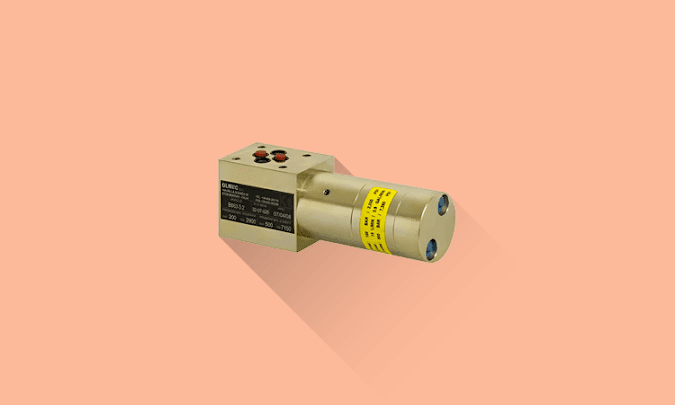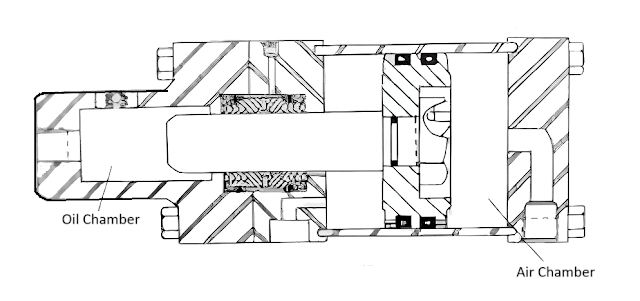Types of Hydraulic Intensifier - Construction, Applications and Benefits
🔗Construction and working of Hydraulic Intensifier
Types of Intensifiers
Hydraulic intensifiers can be classified into two main types: single-acting and double-acting intensifiers. These two principal types have undergone extensive modifications to align with the industry’s specific needs. The choice of intensifier depends on factors such as construction and working medium. The following types of intensifiers are commonly utilised:
1. Single-acting intensifier
2. Double-acting intensifier
3. Air Oil intensifier
Single-Acting Intensifier
Construction and Working of Single Acting Intensifier
A Single Acting Intensifier consists of two chambers: a low-pressure chamber with a relatively larger area and a high-pressure chamber with a smaller cross-sectional area. Its design incorporates a piston with two active regions, where the larger end is situated within the low-pressure chamber, while the smaller end is positioned in the high-pressure area. The low-pressure fluid exerts a force on the piston equal to Pp x A (Pp representing the pump pressure and A denoting the larger piston area). This force is transmitted to the smaller side of the piston. However, due to the smaller area on the high-pressure side, the same force generates a higher pressure within this chamber.
In single-acting intensifiers, pressure is typically boosted intermittently, providing high-pressure fluid solely during the extension stroke of the boosting piston. While this intermittent high-pressure flow is satisfactory for many applications, it fails to meet the requirements of systems that demand a continuous supply of high-pressure fluid. To overcome this limitation, two single-acting intensifiers are often paired together, providing high-pressure fluid continuously. However, such a configuration requires an additional sequencing control mechanism to ensure the coordinated operation of the two intensifiers, guaranteeing a reliable and uninterrupted fluid supply. One practical solution to tackle this challenge involves the utilisation of a double-acting intensifier.
Double-Acting Intensifier
Construction and Working of Double Acting Intensifier
A double-acting intensifier is shown in the figure. A double-acting intensifier comprises a large piston with a piston rod (actuating piston) extending to both sides of the piston (boosting pistons). The larger piston area is exposed to the low-pressure fluid in a shared large cylinder as the common actuator for both boosting cylinders. At the same time, the piston rod is connected to the high-pressure side on both sides of the piston. When low-pressure fluid enters either side of the large piston, it initiates piston movement. This piston movement subsequently drives the piston rod, resulting in the expulsion of fluid at high pressure. The double-acting intensifier exhibits symmetry about the vertical centerline, enabling the piston to move in either direction and produce intensified fluid output from either outlet end. As a result, the double-acting intensifier effectively replicates the operational characteristics of two single-acting intensifiers.
Air-Oil Intensifier
The intensifier can be operated through either air or oil pressure to achieve the desired ultimate pressure. Despite their differing mediums, both methods share a similar design. The air-operated type offers a notable advantage by eliminating the need for a hydraulic power device. This type of intensifier is commonly utilised in air-operated hydraulic presses to reduce construction costs. Additionally, air operation provides the benefit of a rapid response, ensuring swift and efficient performance.
Construction and Working of Air Oil Intensifier
The air oil intensifier operates by replacing low-pressure oil with pressurised air. Certain types of air-oil intensifiers can generate a hydraulic pressure output of up to 200 bar. The Air-Oil intensifier, as illustrated in the figure, consists of an air cylinder and a booster cylinder. It is important to note that the construction on the air side is lighter, while the hydraulic fluid side is sturdy. Heavy-duty V-type sealing is used to seal between the air and oil chambers. Air-oil intensifiers are primarily employed in clamping devices, as air is readily available from a common source in industrial settings. They are also utilised in press operations and punching machines. One key advantage of air-oil intensifiers is their suitability for explosive atmospheres, as they do not require electrical equipment.
Inline And Parallel Hydraulic Intensifiers
Two specialised types of hydraulic intensifiers are used for water jet-cutting applications. The first and widely utilised type is the inline hydraulic intensifier. This mechanism utilises oscillating hydraulic pistons to compress water, achieving the necessary pressure levels. The cutting head of the water jet system regulates the water flow, generating the desired pressure and accurately directing it onto the workpiece. A hydraulic accumulator is necessary to reduce pressure vibrations at the output end.
On the other hand, the parallel hydraulic intensifier, a more recently developed design, also utilises oscillating pistons for water compression. However, this design incorporates multiple cylinders that function in parallel, ensuring that at least one cylinder is always in compression mode. By adopting this approach, pressure fluctuations commonly observed in inline designs are minimised, and the need for an accumulator is eliminated. As a result, the parallel hydraulic intensifier offers improved efficiency and reliability.





